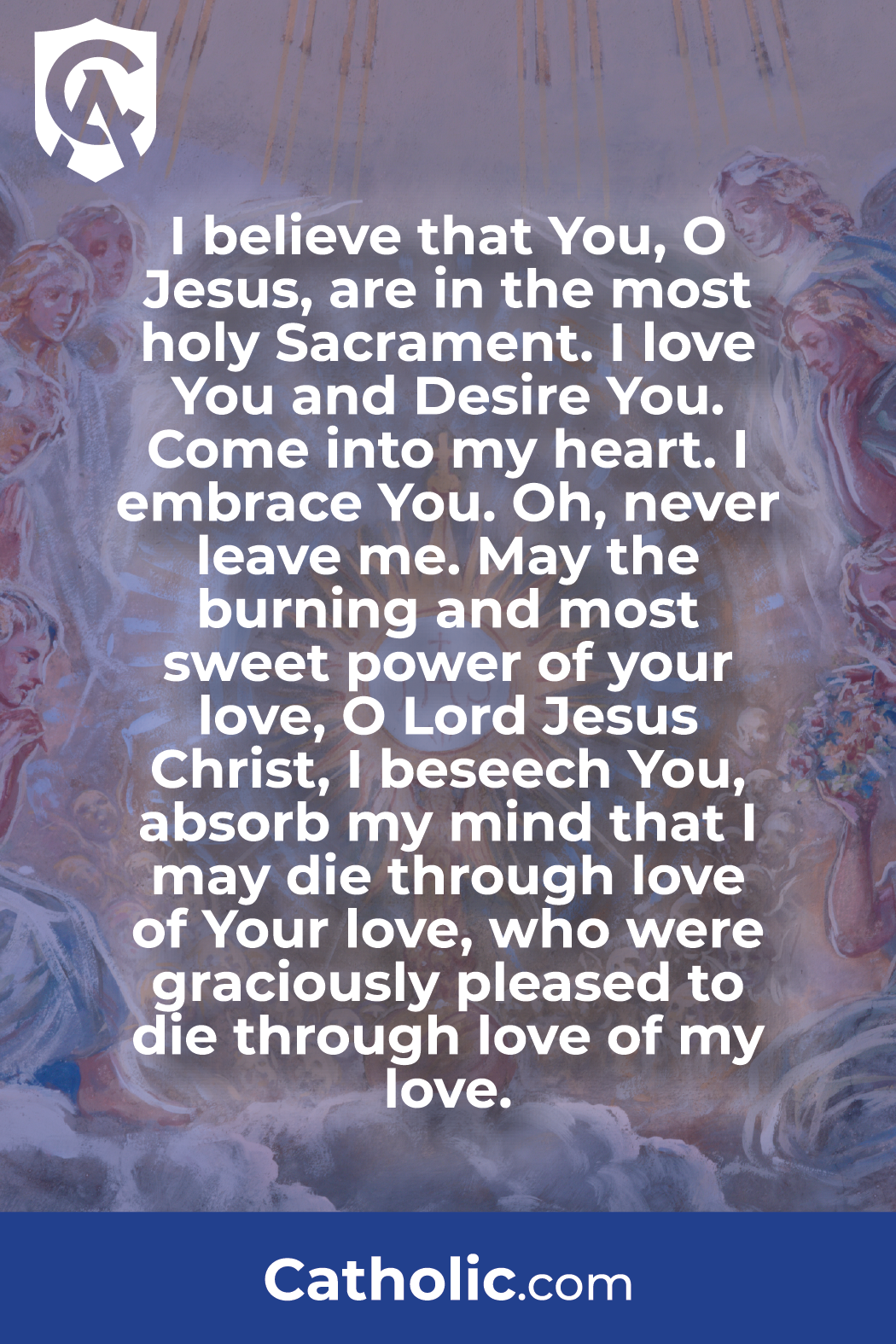
What Is Eucharistic Adoration?
Eucharistic adoration is a time for prayer in which Christians—particularly the Catholic faithful—adore our Lord Jesus Christ in the Most Blessed Sacrament. Adoration can take place either when the Church reserves our Eucharistic Lord Jesus in the tabernacle, or when a priest or deacon exposes the consecrated Host in a monstrance outside of Mass. This type of worship logically flows from the Catholic dogma that Jesus is truly and sacramentally present—body, blood, soul, and divinity—in the Eucharist, in this case under the appearance of bread in the consecrated Host.
In adoration, Catholics seek to revere and encounter deeply our Lord in the Eucharist. It is a wonderful time for prayer, thanksgiving, and worship.
The Origins of Eucharistic Adoration
Eucharist adoration began at the Last Supper, when Jesus instituted the holy sacrifice of the Mass, and the apostles revered and received him in the Most Blessed Sacrament. In the early Church, the Church affirmed the Real Presence, including by reserving the Eucharist for the sick and dying. In addition, within the Mass, St. Augustine says matter-of-factly of receiving the Eucharist, that
No one eats that flesh, unless he has first worshipped . . . and . . we sin not in worshipping (Expositions on the Psalms, Ps. 98 [99], 8).
As is often the case, our Lord helps the Church deepen her understanding of sacred truth through confronting heresy, in this case when Pope Gregory VII required Berengarius of Tours to affirm the Real Presence in 1079[1] (Rom. 8:28). As a result, reverence for the Blessed Sacrament grew over subsequent centuries. St. Francis of Assisi had a great devotion to our Eucharistic Lord, and, in 1226, weeks before St. Francis died, King Louis VII of France asked the Bishop of Avignon to expose the Eucharist in the Chapel of the Holy Cross, resulting in the first extended or perpetual adoration of the Eucharist.
Twenty years later, in 1246, Corpus Christi was first celebrated in the Diocese of Liège, and later, in 1264, a year after the Eucharistic Miracle of Bolsena in central Italy, Pope Urban IV instituted Corpus Christi as a universal feast in the Church. These events fueled Eucharistic adoration through the rise of public processions, and, in turn, helped evangelize Europe.
Unfortunately, in the 1500s, belief in the Real Presence and adoration of the Eucharist faced varying and major opposition among the first Protestant leaders, and yet their quest for a reformed Christian unity ironically splintered over their own disagreements about the Eucharist—the Sacrament of Unity (1 Cor. 10:16-17).
What Is Adoration of the Blessed Sacrament?
Adoration of the Blessed Sacrament, also known as adoration of the Eucharist or adoration of the Holy Eucharist, is an act of worship and thus given to God alone. In adoration, Catholics worship and glorify Jesus Christ who is truly present in the Eucharist. Worship (latria) differs markedly from the veneration and honor (dulia and hyperdulia) given to the saints, especially the Blessed Mother.
During exposition of the Blessed Sacrament, the consecrated Host is placed in a monstrance and set on the altar by either a priest or deacon. Traditionally, a hymn is sung at the beginning, typically O Salutaris Hostia, which St. Thomas Aquinas wrote at the behest of Urban IV for the first universal celebration of Corpus Christi in 1264. A period of meditative adoration follows, enabling the faithful to silently gaze upon Eucharistic Lord, so that they can better hear his “still, small voice” (1 Kings 19:11-13). It provides a solemn time read to Scripture, pray the rosary, or otherwise prayerfully sit in God’s presence, so that we can intimately encounter Jesus in the Eucharist.
What Is Benediction?
After the time of adoration comes benediction, when the priest or deacon, and also the faithful, join in singing a hymn and offer other prayers. During benediction, those gathered traditionally sing Tantum Ergo, another hymn which Urban IV had St. Thomas Aquinas write for the celebration of Corpus Christi. After the hymn, the faithful remain kneeling while the priest or deacon incenses the Eucharist if exposition has taken place with a monstrance. After this, the ordained minister will raise the monstrance and bless the faithful gathered with the Blessed Sacrament, making the sign of the cross over them. Then the congregation recites the Divine Praises:
Blessed be God.
Blessed be his holy name.
Blessed be Jesus Christ, true God and true man.
Blessed be the name of Jesus.
Blessed be his Most Sacred Heart.
Blessed be his Most Precious Blood.
Blessed be Jesus in the Most Holy Sacrament of the altar.
Blessed be the Holy Spirit, the Paraclete.
Blessed be the great Mother of God, Mary most holy.
Blessed be her holy and Immaculate Conception.
Blessed be her glorious Assumption.
Blessed be the name of Mary, Virgin and mother.
Blessed be Saint Joseph, her most chaste spouse.
Blessed be God in his angels and in his saints.
The priest or deacon then removes the consecrated Host from the monstrance and proceeds to place our Eucharistic Lord in the tabernacle. Meanwhile, the faithful stand and sing a concluding hymn, typically Holy God We Praise Thy Name.
What to Do During Eucharistic Adoration
Many non-Catholics, and also Catholics, ask, “What do I do during adoration?” The answer is simple—spend time with Almighty God. He is truly present in the Eucharist, and yearns to encounter you. God is everywhere, and yet God doesn’t manifest himself most intimately everywhere on earth. In the Old Covenant era, the most intimate encounter took place in the holy of holies, which only the high priest could enter—and he only once a year for the Yom Kippur/Day of Atonement sacrifices (Lev. 16:1-2, 34). Any other piercing of the veil would result in the death of the high priest or anyone else. Jesus sacrificially died to reconcile us with the Father, symbolized by the tearing of the veil (Luke 23:44-45), so that we all could draw near for intimate communion with him. Not only can we commune with him at Mass, including through reverent reception of the Blessed Sacrament, but also in Eucharistic adoration—as the church sanctuary and tabernacle is the New Covenant analogue to the Old Covenant holy of holies and the Ark of the Covenant, respectively.
During adoration, some people choose to pray the rosary, others meditate on Scripture, and others simply sit in silent prayer. There is no single “right way” to pray, although typically silence is observed unless perhaps if the faithful pray the rosary together out loud. Our Lord wants us to make time for adoration for our benefit, not his, so if we reverently wait on the Lord in prayer, he will bless us in one way or another (Matt. 6:33)
Whether you stay a few minutes or a full holy hour, all are welcome to rest and rejoice in God’s presence.
Free Download | Adoration & Benediction Prayer Card
What Is Perpetual Eucharistic Adoration?
Perpetual adoration refers to the continuous exposition of Jesus Christ in the Eucharist: twenty-four hours a day, seven days a week. Parishes with perpetual adoration often have an adoration chapel where the Blessed Sacrament is often exposed in a monstrance, though also sometimes reserved in the tabernacle. Volunteers commit to spend at least one hour in the chapel every week, so that our Lord is never left alone. This is to give due honor and worship to our Eucharistic Lord for one hour, similar to what he asked of St. Peter in the Garden of Gethsemane:
Could you not watch[g] with me one hour? (Matt. 26:40).
Having someone always present with the Lord also serves to preempt desecration of the Eucharist.
Perpetual eucharistic adoration reflects the Church’s ceaseless love for the Lord, mirrors the everlasting praise given to God in heaven (see Rev. 5:11-14), and offers the faithful a place for prayer at anytime of the day.
Why Go to Eucharistic Adoration?
Why should Catholics go to adoration? Because it provides a direct, intimate encounter with our Eucharistic Lord Jesus Christ. Spending time in prayer with our Lord in the Blessed Sacrament is an incredible way to better hear the voice of God, meditate on his goodness, and take a needed—and edifying—break away from our busy lives. Many saints who’ve gone before us have emphasized the importance of Eucharistic adoration in their spiritual walks, including St. Francis of Assisi, St. John Vianney, and St. Teresa of Calcutta.
In adoration, we receive special graces to live out our Catholic faith. Adoration provides opportunity for silence, reflection and—most important—divine intimacy and his peace that our world cannot provide (John 14:27). As Pope St. John Paul II said,
The Church and the world have a great need for Eucharistic worship. Jesus waits for us in this sacrament of love (Dominicae Cenae, 3).
Commonly Asked Questions
- Who can go to adoration? Anyone can participate in Eucharistic adoration! Atheists, agnostics, Protestant Christians, non-Christian religious, and Catholics are all welcome to pray before the Eucharistic Lord Jesus!
- Is Eucharistic adoration a sacrament? Although Jesus is truly present during adoration—body, blood, soul, and divinity in the Blessed Sacrament, no sacrament is administered. Rather, adoration is a type of worship that liturgically extends from the sacrifice of the Mass.
- How long is Eucharistic adoration? The length of Eucharistic adoration varies from parish to parish, but, if benediction follows, it is typically one hour.
- Where can you find an adoration chapel? You’ll first need to find a parish that offers perpetual adoration. Find a church near you, including by checking your diocesan website, talking to friends and family, and simply Googling “Eucharistic adoration” or “adoration chapel” with your zip code.
- Do Orthodox Christian practice Eucharistic adoration? While our Eastern Orthodox brethren share the same belief in the Holy Eucharist and offer a valid sacrifice of the Mass (Divine Liturgy), they do not typically practice Eucharistic adoration outside of Mass as in the West. Still, the Orthodox treat our Eucharistic Lord with great reverence, including reserving the Blessed Sacrament within their tabernacles in their church sanctuaries.
The Healing Power of Eucharistic Adoration
The purpose of adoration is to adore Jesus Christ in the Eucharist—to give him latria, i.e., worship. Every moment spent before the Blessed Sacrament is a moment well spent, because it draws us closer to Christ’s Sacred Heart.
As we kneel before the Eucharist, we kneel before the Creator of the universe. In adoration, we gaze upon the living Christ, for he is truly present in the Eucharist, longing to draw our hearts closer to his.
Related Content
Articles
Eucharistic Adoration: Good or Bad?
Worship of the Eucharist Outside Mass?
Podcasts
Q & As
Can Deacons Perform Exposition and Benediction?
Why Pray the Rosary During Eucharistic Adoration?
Shop
Adoration Prayer Guide for Parents
[1] See Pope St. Paul VI, Mysterium Fidei, 52.



